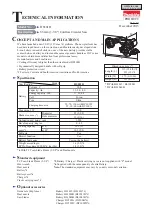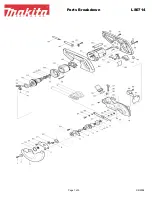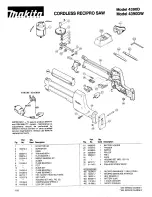
21
Operations
Overview
Familiarize yourself with the location and
operation of all controls and adjustments and the
use of accessories such as the miter gauge and
rip fence.
Kickback
Serious injury can result from kickbacks which
occur when a work piece binds on the saw blade
or binds between the saw blade and rip fence or
other fixed object. This binding can cause the
work piece to lift up and be thrown toward the
operator.
Listed below are conditions, which can cause
kickbacks:
•
Confining the cutoff piece when crosscutting
or ripping.
•
Releasing the work piece before completing
the operation or not pushing the work piece
all the way past the saw blade.
•
Not using the riving knife when ripping or not
maintaining alignment of the riving knife with
the saw blade.
•
Using a dull saw blade.
•
Not maintaining alignment of the rip fence so
that it tends to angle toward rather than
away from the saw blade front to back.
•
Applying feed force when ripping to the
cutoff (free) section of the work piece
instead of the section between the saw
blade and fence.
•
Ripping wood that is twisted (not flat), or
does not have a straight edge, or a twisted
grain.
To minimize or prevent injury from kickbacks:
•
Avoid conditions listed above.
•
Wear a safety face shield, goggles, or
glasses.
•
Do not use the miter gauge and rip fence in
the same operation unless provision is made
by use of a facing board on the fence so as
to allow the cutoff section of the workpiece
to come free before the next cut is started
(see Figure 30).
•
As the machine receives use, the operation
of the anti-kickback pawls should be
checked periodically (Figure 23). If the pawls
do not stop the reverse motion of a
workpiece, resharpen all the points.
•
Where possible, keep your face and body
out of line with potential kickbacks including
when starting or stopping the machine.
Figure 23
Dull, badly set, improper, or improperly filed
cutting tools and cutting tools with gum or resin
adhering to them can cause accidents. Never
use a cracked saw blade. The use of a sharp,
well maintained, and correct cutting tool for the
operation will help to avoid injuries.
Support the work properly and hold it firmly
against the gauge or fence. Use a push stick or
push block when ripping short, narrow (6" width
or less), or thin work. Use a push block or miter
gauge holddown when dadoing or molding.
For increased safety in crosscutting, use the
provided
extension plate
(Figure 24) attached to
the
miter gauge
using the holes provided in the
gauge.
Figure 24
Never use the fence as a length stop when
crosscutting. Do not hold or touch the free end
or cutoff section of a workpiece. On through-
sawing operations, the cutoff section must NOT
be confined.
Always keep your hands out of the line of the
saw blade and never reach back of the cutting
blade with either hand to hold the workpiece.
Bevel ripping cuts should always be made with
the fence on the right side of the saw blade so
that the blade tilts away from the fence and
minimizes the possibility of the work binding and
the resulting kickback.
Содержание 1792000K
Страница 31: ...31 Table Cabinet Assembly ...
Страница 35: ...35 Trunnion Motor Assembly ...
Страница 37: ...37 Blade Guard Miter Gauge Assembly ...
Страница 42: ...42 Notes ...
Страница 43: ...43 ...
















































